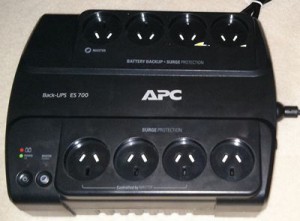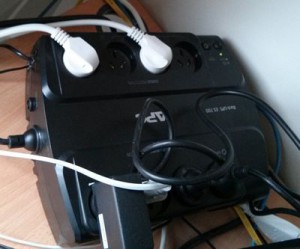In light of my recent power surge woes I’ve gone ahead and bought a UPS. The chosen unit is an APC 700VA ES700. This unit comes with 8 plugs, 4 of which are surge protected and can run from battery power. The other four are just surge protected. I chose this unit because the capacity of 700VA should be enough to keep my file server, my router, my main PC and one monitor active for several minutes in the case of a power interruption. Long enough for me to save my work and gracefully shut down my file server and PC. The battery in the UPS is user-replaceable too which is handy a few years down the track when the battery is shot.
The unit was around $150 and weighs about 8 kilograms. It’s small enough to sit behind my monitors for easy access. The only real set up required was to connect the terminal for the battery and to charge it for 16 hours before usage. Once I’d done that I plugged my PC, a monitor, the router and file server into the UPS enabled plugs. The surge protected plugs were connected to a couple of powerboards that run the rest of my monitors, my partner’s PC, and the network printer. I can verify that the UPS works as advertised because the power happened to flicker on and off not 12 hours after I inserted it into my systems. The unit doesn’t make any noise when operating normally but I did note a hum when the unit was operating from the batter.
There’s a feature of the APC ES-700 that I didn’t use. One of the UPS enabled powerpoints can act as a master and three of the surge protected points can slave from this. When the master is off all power to the slaved powerpoints is stopped, allowing users to save on stand by current draw. This could be ideal if you wanted to use the UPS in your home theater. You could (for example) assign your TV as the master and slave your PVR and hifi system off of that. The documentation also mentions being able to tune the UPS for the current draw of your master device. Seems like a handy feature.


